EQUALITY AND DISCRIMINATION Main Sources: — Mac. Kinnon,


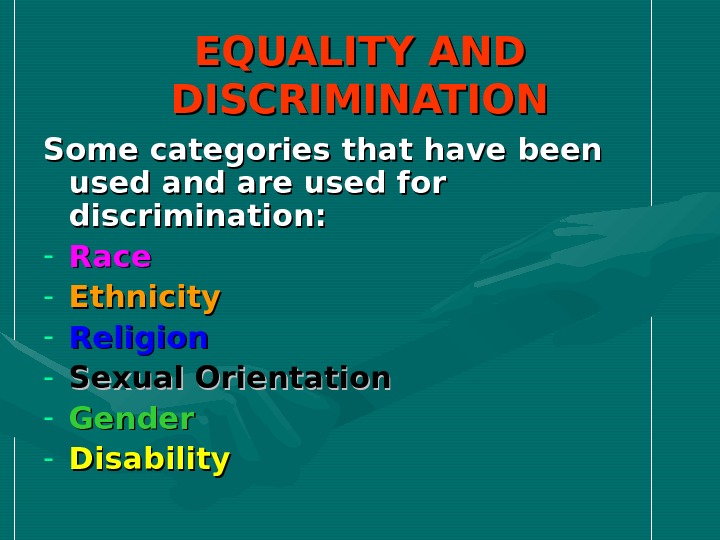

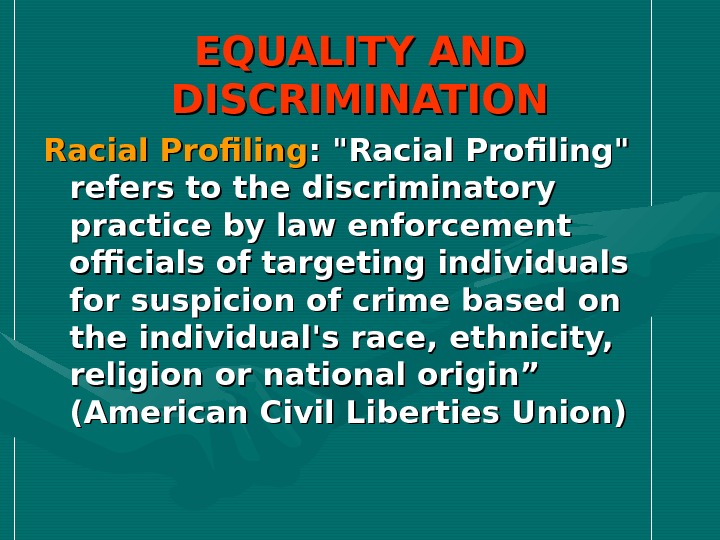









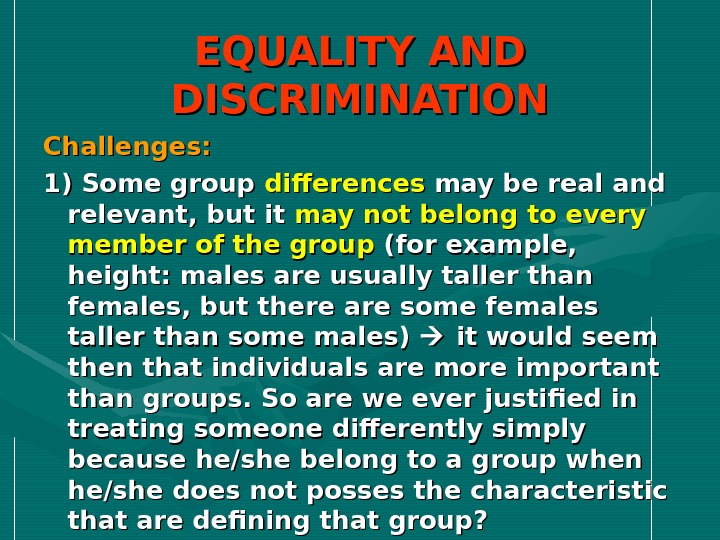


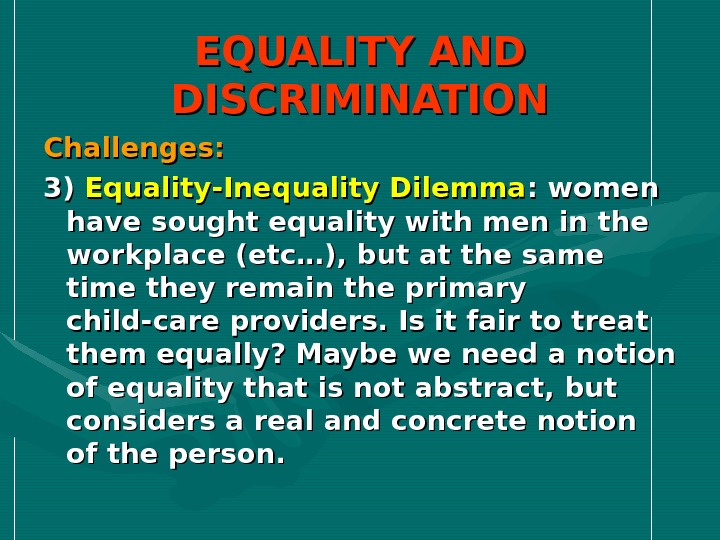

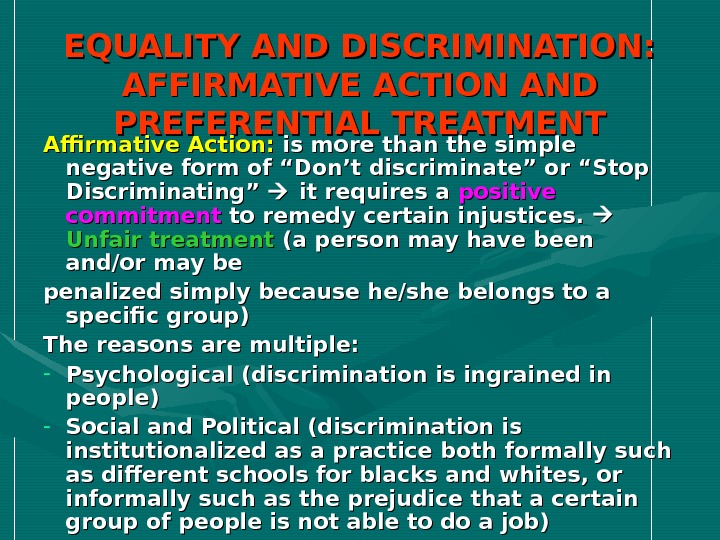





equality_and_discrimination.ppt
- Размер: 115 Кб
- Количество слайдов: 24
Описание презентации EQUALITY AND DISCRIMINATION Main Sources: — Mac. Kinnon, по слайдам
 EQUALITY AND DISCRIMINATION Main Sources: — Mac. Kinnon, Chapter 12 — SEP, Race
EQUALITY AND DISCRIMINATION Main Sources: — Mac. Kinnon, Chapter 12 — SEP, Race
 EQUALITY AND DISCRIMINATION Some categories that have been used and are used for discrimination: — Race — Ethnicity — Religion — Sexual Orientation — Gender — Disability
EQUALITY AND DISCRIMINATION Some categories that have been used and are used for discrimination: — Race — Ethnicity — Religion — Sexual Orientation — Gender — Disability
 EQUALITY AND DISCRIMINATION Stereotypes Italians are ‘mafia’ Don’t trust an Uzbek Women are not good drivers ““ White Trash” ……
EQUALITY AND DISCRIMINATION Stereotypes Italians are ‘mafia’ Don’t trust an Uzbek Women are not good drivers ““ White Trash” ……
 EQUALITY AND DISCRIMINATION Racial Profiling : «Racial Profiling» refers to the discriminatory practice by law enforcement officials of targeting individuals for suspicion of crime based on the individual’s race, ethnicity, religion or national origin” (American Civil Liberties Union)
EQUALITY AND DISCRIMINATION Racial Profiling : «Racial Profiling» refers to the discriminatory practice by law enforcement officials of targeting individuals for suspicion of crime based on the individual’s race, ethnicity, religion or national origin” (American Civil Liberties Union)
 EQUALITY AND DISCRIMINATION One example of racial profiling from the USA: ““ Driving when black” In 1992 in Orlando, Florida, 5% of the drivers were black or Hispanic, but they accounted for 70% of those who were stopped and searched.
EQUALITY AND DISCRIMINATION One example of racial profiling from the USA: ““ Driving when black” In 1992 in Orlando, Florida, 5% of the drivers were black or Hispanic, but they accounted for 70% of those who were stopped and searched.
 EQUALITY AND DISCRIMINATION Hard Profiling : race is the only factor used to single out persons Soft Profiling : other factors are used for selecting the target of investigation, for example age (young), dress (hooded sweatshirt), time (late night) Think about what would you do if you were a policeman in charge of controlling passengers boarding an airplane. For example, some months after 9/11 at Logan Airport in Boston, you see a group of people with long beards and typical Arab clothes praying toward the Mecca just before boarding on the same airplane. This is a completely normal activity for a Muslim, but would it raise your suspicion given the location (USA) and the particular threat of that time (international terrorism self-defining as Islamic)? Why? Or why not?
EQUALITY AND DISCRIMINATION Hard Profiling : race is the only factor used to single out persons Soft Profiling : other factors are used for selecting the target of investigation, for example age (young), dress (hooded sweatshirt), time (late night) Think about what would you do if you were a policeman in charge of controlling passengers boarding an airplane. For example, some months after 9/11 at Logan Airport in Boston, you see a group of people with long beards and typical Arab clothes praying toward the Mecca just before boarding on the same airplane. This is a completely normal activity for a Muslim, but would it raise your suspicion given the location (USA) and the particular threat of that time (international terrorism self-defining as Islamic)? Why? Or why not?
 EQUALITY AND DISCRIMINATION Hate Crimes : “A hate crime, also known as a bias crime, is a criminal offense committed against a person, property, or society that is motivated, in whole or in part, by the offender’s bias against a race, religion, disability, sexual orientation, or ethnicity/national origin. ” (FBI website)
EQUALITY AND DISCRIMINATION Hate Crimes : “A hate crime, also known as a bias crime, is a criminal offense committed against a person, property, or society that is motivated, in whole or in part, by the offender’s bias against a race, religion, disability, sexual orientation, or ethnicity/national origin. ” (FBI website)
 EQUALITY AND DISCRIMINATION One example of hate crimes: After the bombings in London in July 2005, there were several attacks on mosques and single individuals of Muslim religion. . And a question : is it right to have more severe penalties for crimes motivated by hatred? Or would this be an excessive punishment for the views these people hold, not matter how objectionable they are?
EQUALITY AND DISCRIMINATION One example of hate crimes: After the bombings in London in July 2005, there were several attacks on mosques and single individuals of Muslim religion. . And a question : is it right to have more severe penalties for crimes motivated by hatred? Or would this be an excessive punishment for the views these people hold, not matter how objectionable they are?
 EQUALITY AND DISCRIMINATION Gender Discrimination (or Sexism) : : — Women’s career opportunities — Women’s wages — ““ honor killings” (5, 000 females every year) — Sexual harassment (it does not apply to women only!)
EQUALITY AND DISCRIMINATION Gender Discrimination (or Sexism) : : — Women’s career opportunities — Women’s wages — ““ honor killings” (5, 000 females every year) — Sexual harassment (it does not apply to women only!)
 EQUALITY AND DISCRIMINATION THE PRINCIPLE OF EQUALITY Treat equals equally and unequals unequally In a more complex definition: ““ It is unjust to treat people differently in ways that deny to some of them significant social benefits unless we can show that there is a difference between them that is relevant to the differential treatment”
EQUALITY AND DISCRIMINATION THE PRINCIPLE OF EQUALITY Treat equals equally and unequals unequally In a more complex definition: ““ It is unjust to treat people differently in ways that deny to some of them significant social benefits unless we can show that there is a difference between them that is relevant to the differential treatment”
 EQUALITY AND DISCRIMINATION — Justice and the metaphor of a blindfolded woman with a scale in her hand: laws should be applied equally and there should be valid reason for differential treatment — Social Benefits and Harms : we can favor our friends and families in our private lives without any justification, but when we are in a public (social) space we need to justify any differential treatment — Proof : we must show or prove that certain differences exist that justify treating people differently in socially significant ways
EQUALITY AND DISCRIMINATION — Justice and the metaphor of a blindfolded woman with a scale in her hand: laws should be applied equally and there should be valid reason for differential treatment — Social Benefits and Harms : we can favor our friends and families in our private lives without any justification, but when we are in a public (social) space we need to justify any differential treatment — Proof : we must show or prove that certain differences exist that justify treating people differently in socially significant ways
 EQUALITY AND DISCRIMINATION Real Differences: we need to show or prove that actual differences exist between the people we would treat differently. For example, it is not surprising that men and women look so different give the different kind of processes of socialization they have been subjected to. If this is the case than the system is unfair: if women are raised in order to develop certain skills and attitudes, then they cannot be penalized for these traits.
EQUALITY AND DISCRIMINATION Real Differences: we need to show or prove that actual differences exist between the people we would treat differently. For example, it is not surprising that men and women look so different give the different kind of processes of socialization they have been subjected to. If this is the case than the system is unfair: if women are raised in order to develop certain skills and attitudes, then they cannot be penalized for these traits.
 EQUALITY AND DISCRIMINATION Relevant Differences: if women were by nature better at cooking than men, then this would be a ‘real’ difference between them. But we could not use this difference for justifying a priority for women for the job of airline pilot. Characteristics or Skills Is body strength essential for the job of police officer? Is being an Afro-American an essential qualification for teaching university courses in black studies? Here, anyway, the principle of equality is evaluating differential group treatment: what about individuals?
EQUALITY AND DISCRIMINATION Relevant Differences: if women were by nature better at cooking than men, then this would be a ‘real’ difference between them. But we could not use this difference for justifying a priority for women for the job of airline pilot. Characteristics or Skills Is body strength essential for the job of police officer? Is being an Afro-American an essential qualification for teaching university courses in black studies? Here, anyway, the principle of equality is evaluating differential group treatment: what about individuals?
 EQUALITY AND DISCRIMINATION Challenges: 1) Some group differences may be real and relevant, but it may not belong to every member of the group (for example, height: males are usually taller than females, but there are some females taller than some males) it would seem then that individuals are more important than groups. So are we ever justified in treating someone differently simply because he/she belong to a group when he/she does not posses the characteristic that are defining that group?
EQUALITY AND DISCRIMINATION Challenges: 1) Some group differences may be real and relevant, but it may not belong to every member of the group (for example, height: males are usually taller than females, but there are some females taller than some males) it would seem then that individuals are more important than groups. So are we ever justified in treating someone differently simply because he/she belong to a group when he/she does not posses the characteristic that are defining that group?
 EQUALITY AND DISCRIMINATION Two examples : : — The ageage for voting in national elections in most countries is 18. But there are some 17 years old individuals who are more responsible. Is it fair to discriminate on the basis of age? But think about what is the alternative: is it really possible to develop a test of “intelligent/responsible voting abilities”? So in this case it doesn’t seem so unfair the age of 18, considering that if you are 17 you just have to wait for one more year… — But what about not considering someone adequate for a job simply because she belongs to the category of females ? ?
EQUALITY AND DISCRIMINATION Two examples : : — The ageage for voting in national elections in most countries is 18. But there are some 17 years old individuals who are more responsible. Is it fair to discriminate on the basis of age? But think about what is the alternative: is it really possible to develop a test of “intelligent/responsible voting abilities”? So in this case it doesn’t seem so unfair the age of 18, considering that if you are 17 you just have to wait for one more year… — But what about not considering someone adequate for a job simply because she belongs to the category of females ? ?
 EQUALITY AND DISCRIMINATION Challenges: 2) 2) Preferential Treatment Programs : these are programs designed in order to benefit those who have been discriminated against in the past. Would we need to show that every single member of the group was in some way harmed by discrimination in the past? Of course some individuals may not have been harmed, but still in some way their group membership may have affected in subtle ways…
EQUALITY AND DISCRIMINATION Challenges: 2) 2) Preferential Treatment Programs : these are programs designed in order to benefit those who have been discriminated against in the past. Would we need to show that every single member of the group was in some way harmed by discrimination in the past? Of course some individuals may not have been harmed, but still in some way their group membership may have affected in subtle ways…
 EQUALITY AND DISCRIMINATION Challenges: 3) 3) Equality-Inequality Dilemma : women have sought equality with men in the workplace (etc…), but at the same time they remain the primary child-care providers. Is it fair to treat them equally? Maybe we need a notion of equality that is not abstract, but considers a real and concrete notion of the person.
EQUALITY AND DISCRIMINATION Challenges: 3) 3) Equality-Inequality Dilemma : women have sought equality with men in the workplace (etc…), but at the same time they remain the primary child-care providers. Is it fair to treat them equally? Maybe we need a notion of equality that is not abstract, but considers a real and concrete notion of the person.
 EQUALITY AND DISCRIMINATION Challenges: 4) 4) Multiculturalism : a person may identify him/herself more in terms of ethnic background than by race. To what extent should this cultural heritage being promoted? What about those cases when respect for cultural background is leading to gender inequality and discrimination?
EQUALITY AND DISCRIMINATION Challenges: 4) 4) Multiculturalism : a person may identify him/herself more in terms of ethnic background than by race. To what extent should this cultural heritage being promoted? What about those cases when respect for cultural background is leading to gender inequality and discrimination?
 EQUALITY AND DISCRIMINATION: AFFIRMATIVE ACTION AND PREFERENTIAL TREATMENT Affirmative Action: is more than the simple negative form of “Don’t discriminate” or “Stop Discriminating” it requires a positive commitment to remedy certain injustices. Unfair treatment (a person may have been and/or may be penalized simply because he/she belongs to a specific group) The reasons are multiple: — Psychological (discrimination is ingrained in people) — Social and Political (discrimination is institutionalized as a practice both formally such as different schools for blacks and whites, or informally such as the prejudice that a certain group of people is not able to do a job)
EQUALITY AND DISCRIMINATION: AFFIRMATIVE ACTION AND PREFERENTIAL TREATMENT Affirmative Action: is more than the simple negative form of “Don’t discriminate” or “Stop Discriminating” it requires a positive commitment to remedy certain injustices. Unfair treatment (a person may have been and/or may be penalized simply because he/she belongs to a specific group) The reasons are multiple: — Psychological (discrimination is ingrained in people) — Social and Political (discrimination is institutionalized as a practice both formally such as different schools for blacks and whites, or informally such as the prejudice that a certain group of people is not able to do a job)
 EQUALITY AND DISCRIMINATION: AFFIRMATIVE ACTION AND PREFERENTIAL TREATMENT For example: Preference : students belonging to a minority or disadvantaged group will get precedence if they get the same grade in the admission test or in some cases even if they are less-qualified applicants Goals : ideals that we aim for, but are not strictly required, such as increasing the number of unrepresented minorities in jobs Quotas : setting a number or a percentage that should be filled by minorities or underrepresented groups, such as the 50% of candidates for each party in an election should be women
EQUALITY AND DISCRIMINATION: AFFIRMATIVE ACTION AND PREFERENTIAL TREATMENT For example: Preference : students belonging to a minority or disadvantaged group will get precedence if they get the same grade in the admission test or in some cases even if they are less-qualified applicants Goals : ideals that we aim for, but are not strictly required, such as increasing the number of unrepresented minorities in jobs Quotas : setting a number or a percentage that should be filled by minorities or underrepresented groups, such as the 50% of candidates for each party in an election should be women
 EQUALITY AND DISCRIMINATION: AFFIRMATIVE ACTION AND PREFERENTIAL TREATMENT Consequentialist Considerations PROPRO — Promoting mutual respect and harmony in multiracial societies — Benefitting from the diversity of backgrounds — Breaking the past circle of discrimination, disadvantage and inequality — Breaking the disadvantages of belonging to a poor family
EQUALITY AND DISCRIMINATION: AFFIRMATIVE ACTION AND PREFERENTIAL TREATMENT Consequentialist Considerations PROPRO — Promoting mutual respect and harmony in multiracial societies — Benefitting from the diversity of backgrounds — Breaking the past circle of discrimination, disadvantage and inequality — Breaking the disadvantages of belonging to a poor family
 EQUALITY AND DISCRIMINATION: AFFIRMATIVE ACTION AND PREFERENTIAL TREATMENT Consequentialist Considerations CONTRA — These programs don’t work — These programs are benefitting middle-class minorities that would have gained what they were looking for anyway — Stigma on those admitted by affirmative action — Increased racial or gender tensions
EQUALITY AND DISCRIMINATION: AFFIRMATIVE ACTION AND PREFERENTIAL TREATMENT Consequentialist Considerations CONTRA — These programs don’t work — These programs are benefitting middle-class minorities that would have gained what they were looking for anyway — Stigma on those admitted by affirmative action — Increased racial or gender tensions
 EQUALITY AND DISCRIMINATION: AFFIRMATIVE ACTION AND PREFERENTIAL TREATMENT Are these policies really effective? Do they achieve what they aim to achieve? Empirical information The argument pro affirmative action will succeed if it can be shown that there is no better way to achieve the goods it is promoting or that the benefits produced outweighs the harms The argument against affirmative action will succeed if it can be shown that there better ways to achieve the same goals or that the harm produced outweighs the benefits
EQUALITY AND DISCRIMINATION: AFFIRMATIVE ACTION AND PREFERENTIAL TREATMENT Are these policies really effective? Do they achieve what they aim to achieve? Empirical information The argument pro affirmative action will succeed if it can be shown that there is no better way to achieve the goods it is promoting or that the benefits produced outweighs the harms The argument against affirmative action will succeed if it can be shown that there better ways to achieve the same goals or that the harm produced outweighs the benefits
 EQUALITY AND DISCRIMINATION: AFFIRMATIVE ACTION AND PREFERENTIAL TREATMENT Non-consequentialist Considerations Compensation for past wrongs VSVS Reverse Discrimination
EQUALITY AND DISCRIMINATION: AFFIRMATIVE ACTION AND PREFERENTIAL TREATMENT Non-consequentialist Considerations Compensation for past wrongs VSVS Reverse Discrimination

